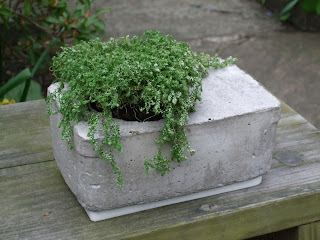This is the story of the first planter in what became an evolving series, which now includes several varieties of vessels with both Corian and wood bases.
The idea was to take the concrete planter idea and adapt it for indoor use. The slice of Corian underneath the concrete adds a nice color contrast and also protects the shelf or table surface from scratches from the concrete.
I chose a rectangular plastic container as my mold. For the base, I measured a rectangle that was slightly smaller than the bottom of the container, cut it out using the circular saw and a fine-tooth blade, and rounded the edges off with a file and sanding block.
Then, in order to make the Corian bond to the concrete, I drilled holes (at slow speed) in each corner of the Corian rectangle, counter-sunk the holes, and fitted in flat-head bolts. I put nuts half-way down each bolt for the concrete to grab onto. In later models, I switched to wing nuts, then abandoned the bolts for screws (a tighter seal) and used jar lids wired to the four corner screws as my bonding device.

Next, I prepared the container for the concrete by rubbing a thin film of 3-in-1 oil (later lithium grease or vaseline) around all of the edges. To allow the concrete to form a ledge over the edge of the Corian base, I filled in the gap between the base and the sides of the container with silicone caulk, and let it dry overnight. On later efforts, I rubbed a candle on the edge of the Corian before applying the caulk, which helped in the removal process, but still allowed the caulk to cure.
For this first project, I used pre-mixed, general purpose concrete, but filtered out the large pieces of gravel from the mix. In subsequent projects, I made my own mixes from Portland cement, sand, and various other ingredients.
Before pouring the concrete, I selected a small plastic tub that would make the hole in the top of the planter, and oiled the outside of this tub and set up a piece of wood on two paint cans over my pouring area that would hold the plastic tub at the desired height during the curing process. Then, I poured the concrete nearly to the top of the main container, sunk in the inner tub, filled the main container to the top, leveled the surface of the concrete with a paint stirrer, and set the container under the wood and paint can set-up.

I let the concrete cure for two days then removed the plastic containers. The inner tub came out pretty smoothly, but I had to cut the main container apart with a knife. I then peeled the caulk of the edge of the Corian and rubbed the remaining bits off, using sandpaper for a few stubborn ones. Finally, I cut the inner plastic tub down to that it sat down just under the surface of the planter. P. said she liked the natural surface of the concrete, so I left this one rough, but later versions have looked quite nice and smooth. We added a fern and now look how nice!













